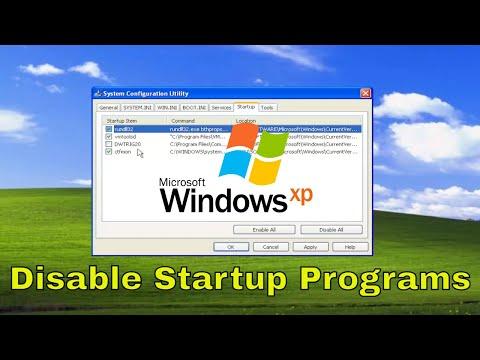A few months ago, I found myself grappling with a sluggish Windows XP system. It was a frustrating experience. My computer, once a reliable workhorse, had slowed to a crawl. Every time I booted up, the startup process seemed to drag on forever, and navigating through my tasks became increasingly painful. As someone who relies heavily on this machine for both work and personal projects, this was a major issue that needed to be addressed quickly.
I did some research and discovered that many startup programs could be the root of my problem. These are the applications that automatically launch when Windows starts up, consuming precious system resources. I knew I needed to streamline this process to regain some of the lost speed and efficiency. Luckily, Windows XP offers a way to manage these startup programs, and I set out to tackle this issue head-on.
First, I decided to start with the built-in tool provided by Windows XP: the System Configuration Utility. To access this, I clicked on the “Start” button and then selected “Run.” In the Run dialog box, I typed “msconfig” and pressed Enter. This action opened the System Configuration Utility, which is a powerful tool that allows users to manage various aspects of their system’s startup process.
Once I was in the System Configuration Utility, I navigated to the “Startup” tab. This tab displays a list of all the programs that are configured to start when Windows boots up. I was overwhelmed by the sheer number of entries listed there. Some were familiar, while others seemed completely foreign to me. This was the first step in identifying what I needed to disable.
To determine which programs were safe to disable, I started by researching each entry online. I found several helpful websites and forums where people discussed the different startup programs and their functions. For instance, some entries were related to antivirus software or essential system components that I knew I should keep enabled. Others were related to software that I rarely used or had installed ages ago and had forgotten about.
I made a list of the programs that were clearly unnecessary for my everyday tasks. For example, I identified some old utility programs and trial software that no longer served a purpose. I also noted down some applications that, while useful, were not essential for startup. For these, I decided it was best to disable them to speed up my boot time.
With my list in hand, I returned to the System Configuration Utility and began unchecking the boxes next to the programs I wanted to disable. I was careful not to uncheck anything that seemed crucial for the system’s operation or security. After making my selections, I clicked “Apply” and then “OK.” A prompt appeared, asking me to restart my computer for the changes to take effect.
I rebooted my computer and observed the results. The difference was noticeable immediately. My system booted up significantly faster, and I no longer experienced the sluggish performance I had grown accustomed to. The desktop loaded quickly, and I was able to start working without the long wait times I had previously endured.
However, I wasn’t completely done yet. While disabling startup programs had undoubtedly improved my computer’s performance, I knew there might still be other underlying issues affecting its speed. To further optimize my system, I decided to delve into additional maintenance tasks. I performed a thorough disk cleanup and defragmented my hard drive. These actions, combined with the reduced number of startup programs, contributed to a smoother and more responsive computing experience.
One thing I learned through this process is the importance of regularly reviewing and managing startup programs. Over time, new applications are installed, and old ones might still linger in the startup list even if they’re no longer in use. Periodically revisiting the System Configuration Utility and performing the same review and cleanup process can help maintain optimal system performance.
In conclusion, dealing with a slow Windows XP system due to excessive startup programs was a challenge that I was able to overcome by taking a systematic approach. By using the System Configuration Utility to manage and disable unnecessary startup programs, I was able to restore a significant amount of speed and efficiency to my computer. The key was careful research and thoughtful decision-making about which programs were truly needed at startup and which could be safely disabled. This experience not only resolved my immediate issue but also provided valuable insights into maintaining a well-performing system.
